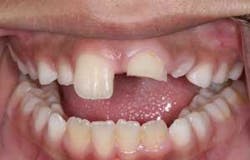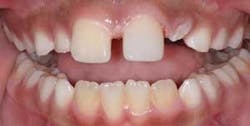Nanohybrid composite restorations Simplified adhesive solutions for the pediatric patient
by Bruce J. LeBlanc, DDS
For more on this topic, go to www.dentaleconomics.com and search using the following key words: nanohybrid composite restorations, pediatric dentistry, Dr. Bruce J. LeBlanc.
Advances in adhesive/cosmetic products have created greater possibilities for us to solve our patients' problems. Many practitioners are concerned about sustaining the quality of their practices in challenging economic environments where patients are encountering financial hardship. It has been my observation that practice health begins with this premise: prevent and solve patients' problems. As the possibilities offered by emerging adhesive/cosmetic products expand, so too does our ability to solve patients' problems and make them happy.
One arena often overlooked in the impact direct composite dentistry can have is the pediatric age group. Yet, this is an age when traumatic injuries that result in fractured teeth are most likely to occur. Imagine the mindset of a parent whose child hits his or her mouth in such a way that in a blink of an eye, half a tooth can disappear. Consider the emotional disability that can develop for a child with a fractured front tooth as he or she becomes aware of the defect.
I remember when I was in sixth grade, a girl in my class who was otherwise very pretty had a front tooth with a dark line at her gums that looked strange to me. It was a flaw in her appearance that had an effect on her psyche. It diminished her confidence during a time when self–esteem can be most important.
At the time, I did not understand that she had a fractured central incisor that had been repaired with a porcelain–over–metal crown that had developed gingival recession, showing the metal finishing line. Also, I did not understand that the reason the tooth did not match the color of the other ones was the difficulty of matching an opaque restoration with the other natural teeth of a 10–year–old girl. This was, quite frankly, state–of–the–art dentistry in the early '70s, and likely was treated very competently during a time when direct composite dentistry was only beginning to emerge.
But little did I know that the observation I made of my sixth–grade classmate would affect the dental care I would offer my patients years later with similar situations. For anyone who has kids, a sudden accident leaving lasting effects, such as a fall that breaks a front tooth, is a very real possibility.
We can draw empathy from our experiences as parents when our patients bring their little ones in with what to them seem like catastrophes with no solution. This can be a practice–building moment for dentists, not unlike the story of the boy who pulled the thorn out of the lion's paw, making a friend for life. But it will be a practice–building moment only if we have the right tools and can develop the abilities to solve the problem.
Fortunately, dental science has evolved since I was in sixth grade, with options today that minimize tooth removal and maximize the ability to duplicate nature. This creates a solution that not only repairs a tooth, but restores the psyche of the patient and parent. Although there are obviously a number of cases I could share where patients sought our care to help solve their child's esthetic crisis, a recent situation serves as an appropriate example.
An 8–year–old son of a patient who recently joined our practice was wrestling with his brother in their bedroom when his upper incisor hit his brother's head and fractured. Unfortunately for the parent, not only did this create a dental emergency, but a medical emergency since she also had to take the brother to the emergency room for stitches to close the wound in his head.
Having solved that problem, she called us to see what could be done with the broken front tooth of her 8–year–old. Consider if this was your child, not knowing what was possible to fix the problem. It is like someone crashing into the side of your brand new automobile that you just drove home from the car dealership. It can be tragic and emotional.
In our practice we have a consult station in a private office with a computer set up for capturing clinical digital X–rays and photographic images that allow us to triage the patient's condition and address concerns. We also display photos of similar cases we resolved, and this allows us to discuss the best possible solutions. This is powerful in creating the ingredient in the doctor/patient relationship that I value most — trust. When trust is part of the relationship, fear begins to disappear and much can be accomplished.
Fig. 1 shows our patient as he presented initially. Clinical evaluation was completed to determine the problems and challenges. In this case, half a tooth was missing and the possibility of nerve damage needed to be addressed. We concluded with confidence during the evaluation that the nerve was not compromised and that a restoration could be placed without a root canal. Of course, follow–up care will reveal if that was accurate, knowing that a root canal could be accomplished subsequently without difficulty since the restoration chosen by the patient was a nanohybrid direct composite.
Nanohybrids are a manufactured formulation that combines the strength of a traditional hybrid with the polishability of a microfill. The latest generation of nanohybrid composites, introduced several years ago, creates durable restorations that maintain a glossy shine for many years. This is important for maximized esthetics as well as reduced plaque and stain accumulation.
Nanohybrids are truly universal in application and are an appropriate choice for posterior as well as anterior teeth. Premise and Herculite Ultra are examples of two nanohybrid formulations I routinely use. For this case, I chose Premise Shade A1 nanohybrid composite to rebuild the missing tooth structure. Appropriate care was taken to apply the bonding agent and then build in and shape the composite. The solution was accomplished in one visit, restoring both the patient's tooth and her psyche. See Fig. 2.
The rewards of our work can be many, but nothing brings me more satisfaction than being part of a restoration that will ultimately impact a patient's life with such significance. For dentists, those moments often present themselves. If we can serve the patient's best interest with our best care, skill, and judgment, then we can not only become financially successful, but experience true joy.
Bruce J. LeBlanc, DDS, publishes articles and provides seminars internationally on adhesive/cosmetic techniques. His practice offers minimally invasive adhesive/cosmetic solutions. He is a product consultant to dental manufacturers and course director for “Simplified Adhesive/Cosmetic Solutions” at LSU School of Dentistry. Reach him via e–mail at [email protected].


